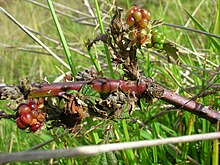| Rubus armeniacus Himalayan Blackberry |
|
|---|---|
 |
|
| Shoot with immature fruit | |
| Scientific classification | |
| Kingdom: | Plantae |
| (unranked): | Angiosperms |
| (unranked): | Eudicots |
| Order: | Rosales |
| Family: | Rosaceae |
| Genus: | Rubus |
| Subgenus: | Rubus |
| Species: | R. armeniacus |
| Binomial name | |
| Rubus armeniacus | |
Himalayan Blackberry, is a species of Rubus in the blackberry group Rubus subgenus Rubus series Discolores (P.J. Müll.) Focke. It is native to Armenia in southwest Asia, and widely naturalised elsewhere. Both its scientific name and origin have been the subject of much confusion, with much of the literature using one or the other of the two synonyms, and often mistakenly citing its origin as western European.
Cultivation
Berry crop
The species was introduced to Europe in 1835, and Australasia and North America in 1885. It was valued for its fruit, similar to that of common blackberries (Rubus fruticosus and allies); but larger and sweeter, making it a more attractive species for both domestic and commercial fruit production. The cultivars “Himalayan Giant” and “Theodore Reimers” are particularly commonly planted.[1][2]
Invasive species
Himalayan Blackberry was first introduced to America from Europe in the late 1800s as a cultivated crop. Because it is so hard to contain, HBB quickly got out of control, with birds and other animals eating the berries and then spreading the seeds. From this, HBB eventually spread to the Pacific Northwest, where it is now widespread.[5] Rubus armeniacus soon escaped from cultivation and has become an invasive species in most of the temperate world.[1][2][6][7]
http://en.wikipedia.org/wiki/Himalayan_Blackberry




